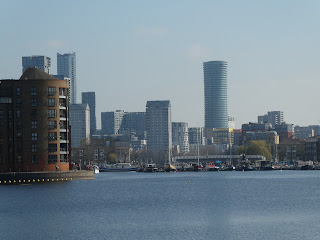This is not an area of London that I know well. Nor I suspect do many people. It essentially consists of old docks from the days when this was England's main port for European trade, but it lost all its container trade over the course of the 20th century. So, it is now in the course of regeneration. Well, largely it has been regenerated over the course of my lifetime. Just that some bits of regeneration are easier and more glamorous than others. So Canary Wharf is more glamorous, and, say St Katherine's Dock much easier as so close to central London; this area is just a little out on a limb. There is still some development going on, but it is mostly done. Not going to get heaps better.
So I started this walk at Canada Water - a dramatically designed station at one end of what was Canada Dock when it was a dock. It is now just a lake in the middle of a group of shops, not chi chi shops but the sort of warehouse out of town supermarket types like Decathlon and Tescos
The station is under this. As I say, dramatic building. Not attractive, but not boring.
The sculpture is supposed to represent the honest toil of the old dock workers, called the deal porters. The main import trade for a long time was of timber from Scandinavia, specifically softwood, known also as "deal". It seems this statue was sculpted in deal, but then converted into bronze, which seems to negate the point. And in any case the result is that while intriguing from a distance, it just looks a bit crude close up. No doubt reflecting the limitations of the deal (and possibly the sculptors).




























































No comments:
Post a Comment